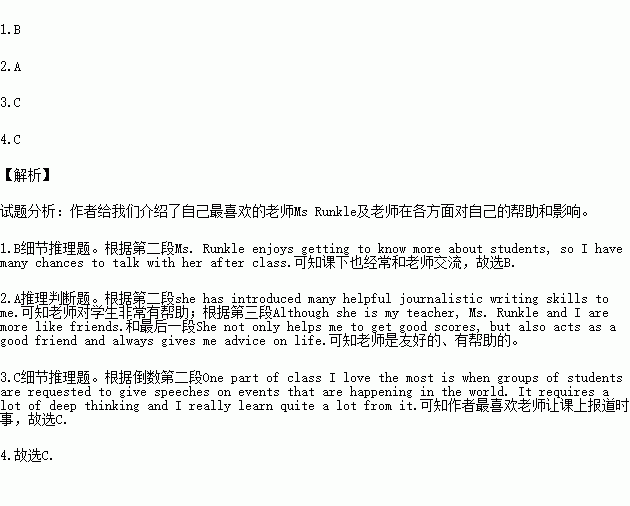题目内容
I have many new teachers in high school, but Lori Runkle, my English Language and Composition teacher, is my favorite teacher.
Ms. Runkle enjoys getting to know more about students, so I have many chances to talk with her after class. I have always wanted to become a journalist (新闻记者). Since Ms. Runkle used to be a journalist back in the United States, she has introduced many helpful journalistic writing skills to me.
Although she is my teacher, Ms. Runkle and I are more like friends. She often invites my classmates and me to take part in different activities outdoors. For example, I went to listen to a journalist’s speech, which helped me better understand current events (时事).
Not only does Ms. Runkle talk with me outside of school, she is also a great teacher in the classroom. English Language and Composition is a really hard subject for a second language learner. We felt worried in the beginning, but Ms. Runkle really makes an effort to help us out. In class, Ms. Runkle always encourages students to question everything to keep us active. One part of class I love the most is when groups of students are requested to give speeches on events that are happening in the world. It requires a lot of deep thinking and I really learn quite a lot from it.
I love Ms. Runkle very much. She not only helps me to get good scores, but also acts as a good friend and always gives me advice on life.
1.After class, the author ____________.
A. seldom sees Ms. Runkle
B. talks with Ms. Runkle quite a lot
C. enjoys introducing Ms. Runkle to her friends
D. often invites Ms. Runkle to different activities
2.We can infer (推断) from the passage that Ms. Runkle is ___________ .
A. friendly and helpful B. kind and humorous
C. clever and active D. strict and boring
3.The author’s favorite part of Ms. Runkle’s class is when Ms. Runkle ___________ .
A. tells them how to get good scores
B. asks them questions about the world
C. asks them to describe current events
D. tells them about events that are happening
4.What is the author’s purpose of writing this passage?
A. To express how much she misses Ms Runkle.
B. To look back on her special high school life.
C. To describe an unforgettable teacher.
D. To show what makes a good teacher.
 阅读快车系列答案
阅读快车系列答案
